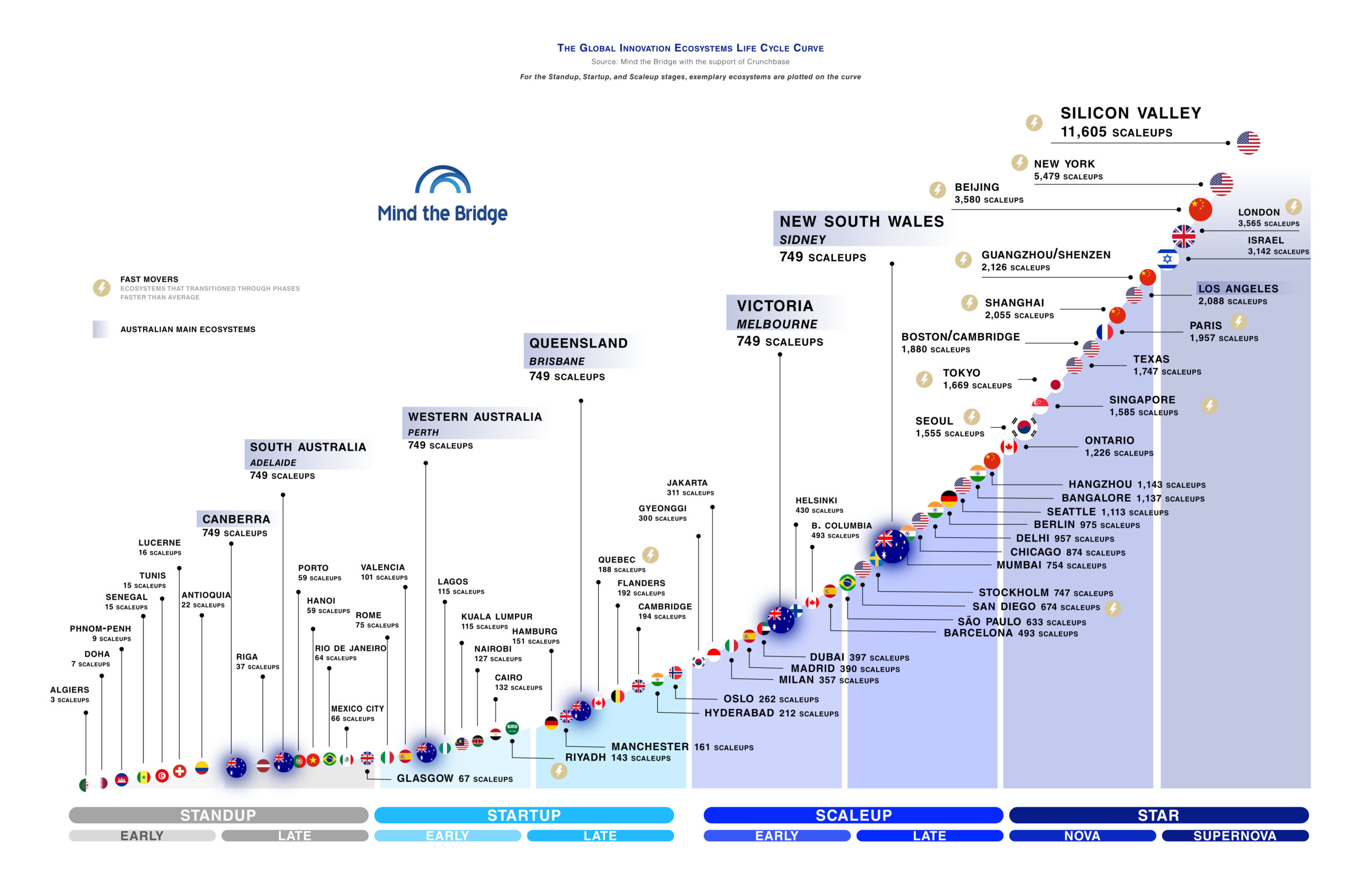By Alberto Onetti
For some time now, I’ve been pointing out how Australia has been making significant progress, positioning itself as a strong competitor among the innovation ecosystems of the Asia-Pacific region.
The Scaleup Summit Australia, which Mind the Bridge organizes every October with the support of Investment NSW, offers a good opportunity to take stock — also thanks to the data and analysis from the “Tech Scaleup Australia 2025” report, published with the support of Crunchbase and Acciona.
The numbers
Australia is home to 1,582 scaleups — almost six scaleups per 100,000 inhabitants, a remarkable number considering the country’s relatively small population — that have collectively raised more than $36 billion in capital (around 2% of national GDP).
Aside from the major Asian economies (the 2 billion-plus-people nations of China and India, which play in a different league with 12,403 and 4,112 scaleups respectively), Australia’s numbers are not far behind South Korea (2,127) and Japan (2,268), roughly on par with Singapore (1,660), and 3x larger than emerging ecosystems like the UAE (503).
Notably, Australia also stands out as fertile ground for large tech companies — what we call scalers. We identified 71 Australian scaleups that have each raised over $100 million, a number comparable to Japan (86) and South Korea (96).
This can be explained by the relative isolation of the Australian ecosystem, which has encouraged the creation of national champions in strategic sectors for the continent such as construction, mining and energy — collectively referred to as “infratech.”
Infratech: Australia’s house specialty
A closer look at the infratech landscape shows steady growth over the past five years, with venture capital investments rising from $100 million in 2020 to nearly $500 million in 2025.

Among Australian scaleups, about 1 in 10 (107) operate in this vertical, covering the entire value chain: from critical resources (21%) to construction (57%) and energy systems (22%).

Australia’s dominance in mining AI
As highlighted in the “Unlocking the Future of Mining” report developed by Mind the Bridge with support from BHP, Austmine and Hub de Innovación Minera del Perú, and based on dozens of interviews with mining industry experts, large infrastructure projects promoted by local and international corporations (including ACCIONA, BHP and Rio Tinto) are increasingly integrating new technologies such as AI, advanced robotics, computer vision and digital twins.
Therefore, it doesn’t come as a surprise that Australia leads globally, accounting for nearly three quarters of all investments in AI for mining, far ahead of China (12%) and the United States (9%).
Australia’s dominance in mining AI reflects structural strengths that are tough to match. The country combines large-scale mining operations, supportive regulations and a mature ecosystem of mining tech vendors and talent — which made it the global hub for mining innovation.
For companies abroad, this means access to mining AI capabilities now largely depends on partnering with Australian platforms and experts.

Investment landscape: industrial roots, corporate muscle
Investors are also moving into tech areas like space tech, UAVs, drones and autonomous mobility, especially when these intersect with construction and mining applications.
Although Australia’s investor landscape is broad — with 491 active VCs and CVCs currently managing around $32 billion of dry powder available for local scaleup investments (see map on MTB Ecosystem) — it remains largely focused on seed- and early-stage funding (the majority of funds — 73% — are under $50 million).
However, what’s particularly interesting — and consistent with the industrial drive of the Australian ecosystem — is that most of the mega funds (over $1 billion) are corporate venture capital vehicles. Leading examples include Rio Tinto, as well as banks like Macquarie Group, ANZ, National Australia Bank and Commonwealth Bank of Australia.
Specialization attracts international players, dispersion does not
The Australian strong specialization in specific verticals is attracting the interest of global corporates: 26 large international companies have set up innovation outposts Down Under (map available on MTB Ecosystem).
This sends a powerful message in today’s innovation world, where the concentration of investments in a handful of major ecosystems has effectively reduced the visibility of nearly all others, pushing them toward marginalization and irrelevance.
Specialization, whether in technological domains or industrial applications, can help some of these ecosystems stand out and claim their space on the global innovation map.

For more insights on startup and scaleup ecosystems, see Mind the Bridge’s reports (available for free download here).

Alberto Onetti is chairman of Mind the Bridge and a professor at University of Insubria. He is a serial entrepreneur who has started three startups in his career, the last of which is Funambol, among the five Italian scaleups that have raised the largest amount of capital. He is recognized among the leading international experts in open innovation and has wide experience in setting up and managing open innovation projects — venture clients, venture builders, intrapreneurship, CVCs — with large multinational companies, as well as advising and training on this subject. Onetti has a column on Sifted (Financial Times) and several other tech blogs.
Related reading:
Illustration: Li-Anne Dias

Stay up to date with recent funding rounds, acquisitions, and more with the
Crunchbase Daily.








